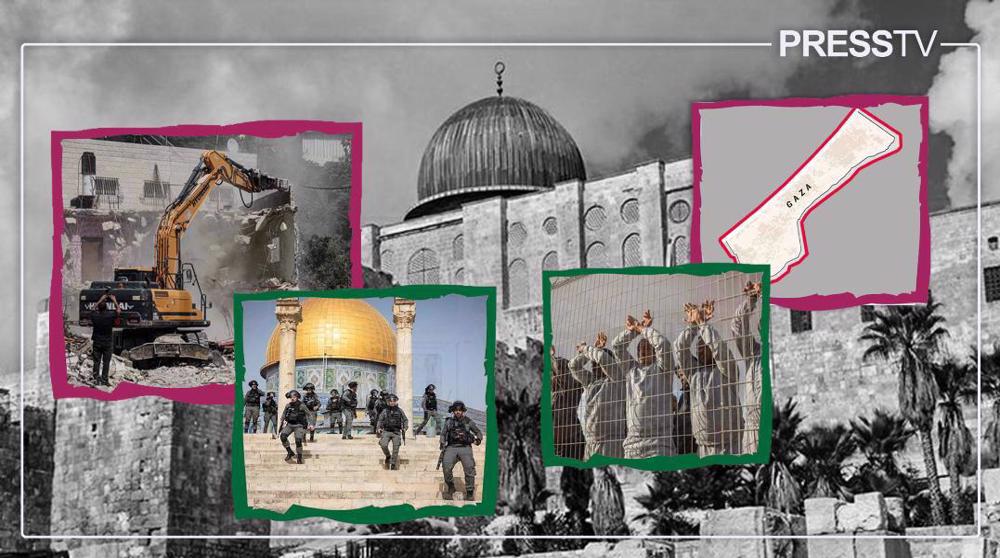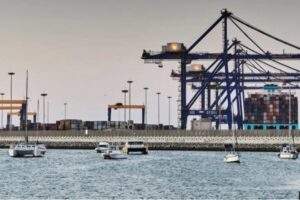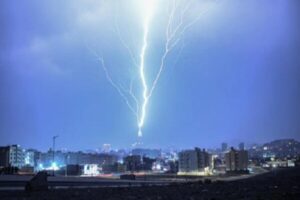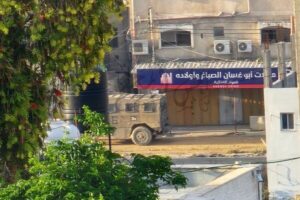By Reza Javadi
The unprecedented military operation launched by the Gaza-based Hamas-led Palestinian resistance factions in the wee hours of October 7 morning against the Israeli regime didn’t happen in a vacuum.
The operation, which began with a rapid burst of thousands of rockets at the occupied territories, took the regime in Tel Aviv by complete surprise, especially after regime soldiers were taken as prisoners.
Quite expectedly, the operation was criticized by the Israeli regime’s Western allies, which described Palestinian resistance fighters as “terrorists” and the regime as “victims.”
As explained by the Hamas political bureau head Ismail Haniyeh after the operation, the operation was a natural response to years of Israeli apartheid and unrelenting atrocities against Palestinians.
The key factors that prompted the Palestinian resistance to launch the ‘Al-Aqsa Storm’ operation (also known as Al-Aqsa Flood) include – the Israeli regime’s arbitrary detention policy, expansion of illegal settlements, the inhumane siege of the Gaza Strip, and the recurrent desecration of Al-Aqsa Mosque.
Israeli detention policy
Following the ‘Al-Aqsa Storm’ operation, Palestinian resistance fighters took hundreds of Israeli regime soldiers and settlers as prisoners of war to exchange them later with Palestinians held in Israeli jails.
The Tel Aviv regime’s so-called “administrative detention” policy has been widely slammed by human rights advocacy groups, under which Palestinians are imprisoned without charge or trial, including women and children, and subjected to ruthless torture and military trials.
Gaza is often referred to as the largest ‘open-air prison’, with 2.2 million people blockaded in a small coastal strip. The number of Palestinians who have spent time in Israeli jails is similarly significant.
Since 1967, an estimated more than one million Palestinians have been arrested by the Israeli occupation forces, as reported by the United Nations last summer.
One in every five Palestinians has been arrested and charged under the 1,600 military orders that govern every aspect of the lives of Palestinians under the Israeli military occupation.
This incarceration rate doubles for Palestinian men, with two in every five having been arrested.
The Palestinian prisoner rights group, Addameer, has depicted the Israeli prison system as a “complex of monstrous machinery in form, laws, procedures, and policies…designed to liquidate and kill.”
Before the surprise military attack by the Palestinian resistance movement on October 7, there were at least 5,300 Palestinians in Israeli jails, including 40 women and 170 children.
Since the attack and the subsequent Israeli assault on Gaza, at least another 870 Palestinians have been arrested, primarily activists from the Hamas resistance group, according to reports.
“Former parliamentarians and Hamas leaders were among the detainees,” Amani Sarahneh, a spokeswoman for the Palestinian Prisoners Society, was quoted as saying last week.
These prisoners are held in 23 notorious prisons and detention centers across the occupied Palestinian territories. The majority of female prisoners are held at the Damon prison, and more than 170 children have been incarcerated at prisons including Ofer, Damon, and Megiddo.
The inhumane condition of prisons and the deteriorating health of many Palestinian prisoners illegally detained by the regime forces were one of the main factors that triggered the October 7 operation.
According to Hamas, the aim of Saturday’s attack against occupation forces was “to free Palestinian prisoners, stop Israeli aggression on al-Aqsa Mosque, and to break the siege on Gaza.”
Expansion of illegal Israeli settlements
The Israeli occupation of Palestine has been marked by the rapid expansion of illegal settlements as part of the settler-colonialism project of the regime aimed at changing the demographic character of Palestine.
It is the defining feature of the Israeli apartheid and occupation and includes Israel forcing Palestinians out of their lands and demolishing their homes to construct illegal settlements.
The UN has in the past condemned this plan as a “strategy of Judaization” that “excludes, discriminates against and displaces minorities, particularly affecting Palestinian communities, side by side with the accelerated development of predominantly Jewish settlements.”
Pertinently, according to international law, all Jewish settlements in the occupied territories are considered illegal. In multiple instances, the occupying authority has unveiled plans to substantially increase funding for these illegal settlements in the occupied West Bank.
Back in September, a senior UN official reiterated an appeal for an end to the occupation and a resolution of the long-running conflict. The appeal was made in light of the expansion of illegal settlements, demolition of Palestinian structures, daily violence and continued rhetoric by the regime officials.
Tor Wennesland, the United Nations Special Coordinator for the West Asia Peace Process, reported that Israeli authorities continued settlement activities by advancing plans for 6,300 housing units in Area C and around 3,580 housing units in occupied East al-Quds.
“In a continuing trend, many Palestinians, including children, left behind their communities citing violence by settlers and shrinking grazing land,” he said, as cited by the UN press agency.
Meanwhile, policies of the Benjamin Netanyahu-led far-right Israeli regime have sought to institutionalize the project of “settler colonialism” in the occupied West Bank and al-Quds, fueling settler violence and frequent attacks on the holy Al-Aqsa Mosque as well as Palestinian properties.
In June, hundreds of Israeli settlers stormed a Palestinian town in the occupied West Bank, setting fire to dozens of cars and homes, after the heavy deployment of Israeli forces across the occupied West Bank, and after Netanyahu announced plans to build 1,000 new settler units in the occupied territory.
Repeated desecration of al-Aqsa Mosque
Over the past decades, Israeli regime forces have repeatedly been involved in the desecration of Al-Aqsa Mosque. In their latest attempt earlier this year, they stormed the holy mosque while Muslims in were observing a religious ritual called Itikaf during Ramadan.
Falsely accusing the worshippers of being “masked agitators”, they stormed the mosque with tear gas, wielding batons aggressively and injuring a number of worshippers.
Videos posted online depicted police beating Palestinians with batons and rifle butts and restraining dozens of worshipers.
“The youths were afraid and started closing the doors,” Talab Abu Eisha, who was there at the time of the raid, told the AP. “It was an unprecedented scene of violence in terms of police brutality.”
The violence at the mosque prompted calls for mass protests by the Hamas resistance group in Gaza.
Palestinian civil affairs minister Hussein al-Sheikh said “The level of brutality requires urgent Palestinian, Arab and international action,” as quoted by the AFP news agency at the time.
In recent months, illegal settlers led by far-right Israeli minister Itamar Ben-Gvir have repeatedly entered the compound of the mosque, angering Palestinians who deem the acts as deeply provocative.
In June, after Ben-Gvir entered the mosque compound, Hamas spokesperson Hazem Qassem termed it a “crime” and affirmed that the site “will remain Palestinian, Arab, Islamic.”
The leader of Lebanon’s Hezbollah resistance movement, Sayyed Hassan Nasrallah, warned that any change in the mosque’s status quo could lead to an explosion in the region, not just occupied territories.
The site holds immense significance for Palestinians as a national symbol, and the storming of the Al-Aqsa Mosque by Israeli security forces was a major trigger for 11 days of violent clashes in 2021.
Following the storming of the holy site, Hamas fired thousands of rockets toward the occupied lands in response, prompting Israel to attack with hundreds of airstrikes and kill more than 200 people in Gaza.
Crippling siege of Gaza
Israel occupied Gaza during the 1967 war and maintained its illegal presence there until 2005.
During this time, it established Jewish settlements in the region. However, in 2005, Israel was forced to withdraw its troops from Gaza, while retaining control over its airspace, shared border and shoreline.
In 2006, the resistance movement Hamas claimed the majority in legislative elections. After that, Israel imposed a blockade on the densely populated Palestinian territory.
The blockade severely limited the movement of goods and people in and out of the coastal strip, exacerbating its humanitarian crisis, as reported by the United Nations in its multiple reports.
“This pressure being put on Palestinians — it just assumes that they’re insignificant and they will tolerate any degree of humiliation, and that’s just not true,” Palestinian scholar Rashid Khalidi of Columbia University writes. “If you had lifted the siege of Gaza, you would not have had this happen.”
In the last two weeks, since the Hamas-led operation, the siege has been intensified, which the Israeli minister of military affairs described as a “complete siege” with no water, food, or electricity supplies.
“We are putting a complete siege on Gaza … No electricity, no food, no water, no gas – it’s all closed,” Yoav Gallant said in a video statement, which drew condemnation worldwide.
Before the latest escalation, the majority of Gazan households were already described as “food insecure”, even water resources have been controlled by the Israeli regime for years.
Last year, the United Nations spokesman in a statement said “nearly 80 percent of Gazans now rely on humanitarian assistance “largely due to poverty, high unemployment rates and other factors.”
“More than half of Gaza’s just over 2 million people live in poverty, and nearly 80 percent of the youth are unemployed,” he noted, urging the Israeli regime to lift the crippling blockade.




